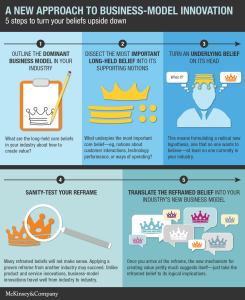In a disruptive age, established business models are under attack. Here’s how incumbent companies can reframe them.
Let’s face it: business models are less durable than they used to be. The basic rules of the game for creating and capturing economic value were once fixed in place for years, even decades, as companies tried to execute the same business models better than their competitors did. But now, business models are subject to rapid displacement, disruption, and, in extreme cases, outright destruction. Consider a few examples:
• Bitcoin bypasses traditional banks and clearinghouses with blockchain technology.
• Coursera and edX, among others, threaten business schools with massive open online courses (MOOCs).
• Tencent outcompetes in Internet services through microtransactions.
• Uber sidesteps the license system that protects taxicab franchises in cities around the world.
The examples are numerous—and familiar. But what’s less familiar is how, exactly, new entrants achieve their disruptive power. What enables them to skirt constraints and exploit unseen possibilities? In short, what’s the process of business-model innovation?
For incumbents, this kind of innovation is notoriously hard. Some struggle merely to recognize the possibilities. Others shrink from cannibalizing profit streams. Still others tinker and tweak—but rarely change—the rules of the game. Should it be so difficult for established companies to innovate in their business models? What approach would allow incumbents to overturn the conventions of their industries before others do? Our work with companies in telecommunications, maritime shipping, financial services, and hospitality, among other sectors, suggests that established players can disrupt traditional ways of doing business by reframing the constraining beliefs that underlie the prevailing modes of value creation. This article shows how.
…
The fuller process and the questions to ask along the way look like this:
1. Outline the dominant business model in your industry.
2. Dissect the most important long-held belief into its supporting notions.
3. Turn an underlying belief on its head. Formulate a radical new hypothesis, one that no one wants to believe—at least no one currently in your industry.
4. Sanity-test your reframe. Many reframed beliefs will just be nonsense.
5. Translate the reframed belief into your industry’s new business model.
Four places to reframe:
Innovating in customer relationships: From loyalty to empowerment
Innovating in activities: From efficient to intelligent
Innovating in resources: From ownership to access
Innovating in costs: From low cost to no cost
…
Big companies have traditionally struggled to innovate in their business models, even as digital technology has brought business-model innovation to the forefront of the corporate agenda. Yet big companies can be disruptive, too, if they identify and overcome common but limiting orthodoxies about how to do business.
Authors: Marc de Jong is a principal in McKinsey’s Amsterdam office, and Menno van Dijk is the cofounder and managing director of the THNK School of Creative Leadership and a former director in the Amsterdam office.
The authors wish to thank Karim Benammar, Berend-Jan Hilberts, and Saskia Rotshuizen for their contributions to this article.
More: www.mckinsey.com
